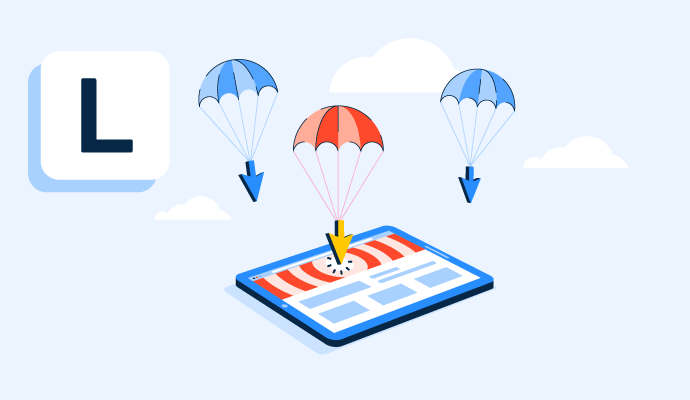What is a landing page?
A landing page is a standalone page on a website created to encourage users to take a specific action. This page isn’t linked from anywhere in the site’s navigation and is typically only accessible via marketing campaign links, like from a social media ad or an in-email button.
An essential part of building a landing page is providing users with something valuable in exchange for doing certain tasks, like joining a mailing list or registering for an event. The landing page might also offer a free download with valuable resources such as an eBook.
Once converted into a lead, businesses collect customer information for their databases and use it to personalize targeted marketing efforts towards those leads, through channels such as paid ads, emails, or direct mailers.
Types of landing pages
Landing pages are generally created to either capture leads directly or encourage users to take action. They fall into two categories.
- Lead generation landing pages: For businesses looking to collect customer information, a lead capture landing page is the most beneficial. Somewhere on the landing page, there should be a form that allows users to input details like name, email address, and any other specific information that the business needs to know.
- Click-through landing pages: The main focus of a click-through landing page is the call to action (CTA) button. This encourages visitors to click and be redirected somewhere else on the website. Common CTAs are “schedule a demo” or “buy now", as these landing pages are built primarily for sales, rather than collecting customer data.
Basic elements of a landing page
The design of a landing page depends on what a business is trying to achieve. But regardless of the intention, a landing page should include:
- Clear directions for users. Once a visitor lands on the page, they should know exactly what is expected of them next. Limiting the number of distracting elements and keeping text to a minimum clarifies the CTA. This could mean removing the navigation for the website entirely from the landing page, keeping the focus on next steps.
- A valuable offer. Users want to get something in return for providing their information or clicking on another page. Compelling offers should be valuable to the customer, like a discount code for their next purchase or access to a tool that helps them with a problem they’re currently facing.
- Succinct forms. No one wants to spend any more time than necessary filling out a lead capture form. Instead, these forms should be kept to only a handful of fields. Name and email address are usually enough.
- Tracking and analytics. Although it’s invisible to users on the page, any business with a landing page should have data tracking enabled. This is particularly useful in knowing how many people came to the page without filling in a lead capture form and helps refine the landing page efficacy.
Benefits of landing pages
Plenty of benefits come from building a landing page. Whatever the company’s goals are, these pages:
- Increase direct conversions. Targeted pages that encourage users to act are one of the best ways to improve conversion rates on a website.
- Provide additional data about customers. As landing pages are only accessible via links in marketing campaigns, tracking data tells the business which methods work better than others. For instance, if significantly more landing page visitors are coming in via a social media ad rather than a direct mailer, this could help save the company money on print costs in the future and lead to greater digital marketing efforts – and more customers – through this channel.
- Tie metrics back to business goals. All businesses should have tangible sales and marketing goals. Landing pages for marketing a new product or service can directly link data to sales and revenue targets to clearly show success via a particular channel or campaign.
- Make a good first impression. It's likely that visitors on a landing page have never heard of the brand before their initial click. A well-designed landing page leaves users with a good first impression of the business. Even if they don’t convert immediately after going to the landing page, it’s more possible that they will return to the site directly in the future if they’ve had a positive experience.
Best practices for landing pages
The goal for any landing page is to increase customer visits, either immediately or in the near future. The most successful landing pages often include:
- Enticing text. Users need to be persuaded to take action. Any text on the landing page should encourage them to behave in a particular way and reinforce the valuable offer they’ll receive if they move forward with the action.
- A CTA above the fold. The action a user should take next should be one of the first elements on the page that customers see. They shouldn’t need to scroll to find out what they need to do. It’s always best to check how the landing page design appears on a mobile device to keep this possible across desktop and other devices.
- High-quality product imagery. For product-based businesses, images or video content about the product should be of the best quality possible to entice users into signing up or clicking through to purchase.
- Repetition of the main CTA If a landing page has a large amount of text, it’s best to repeat the CTA at the top and bottom of the page. This provides several conversion points for a user and increases the likelihood of them taking action, wherever they might find themselves on the landing page.
Make sure the landing page also works for all mobile users by considering mobile optimization techniques.

Holly Landis
Holly Landis is a freelance writer for G2. She also specializes in being a digital marketing consultant, focusing in on-page SEO, copy, and content writing. She works with SMEs and creative businesses that want to be more intentional with their digital strategies and grow organically on channels they own. As a Brit now living in the USA, you'll usually find her drinking copious amounts of tea in her cherished Anne Boleyn mug while watching endless reruns of Parks and Rec.





















